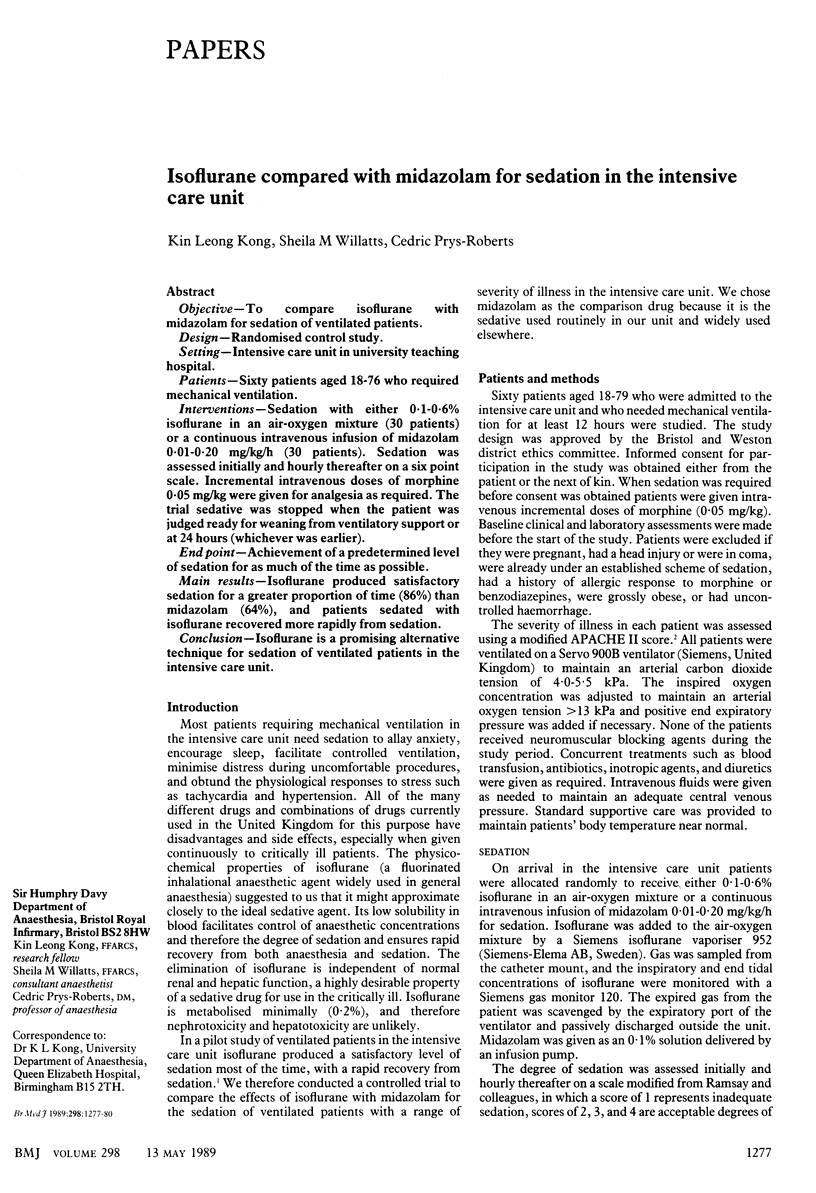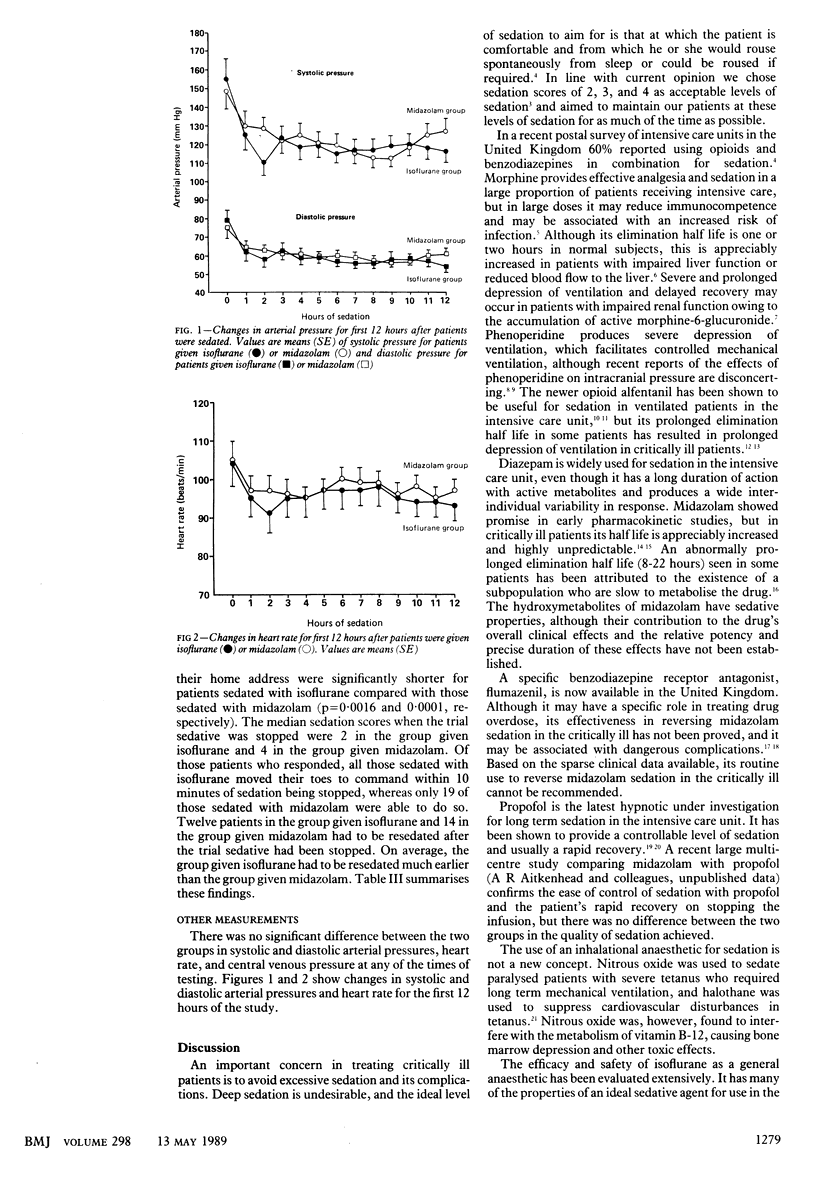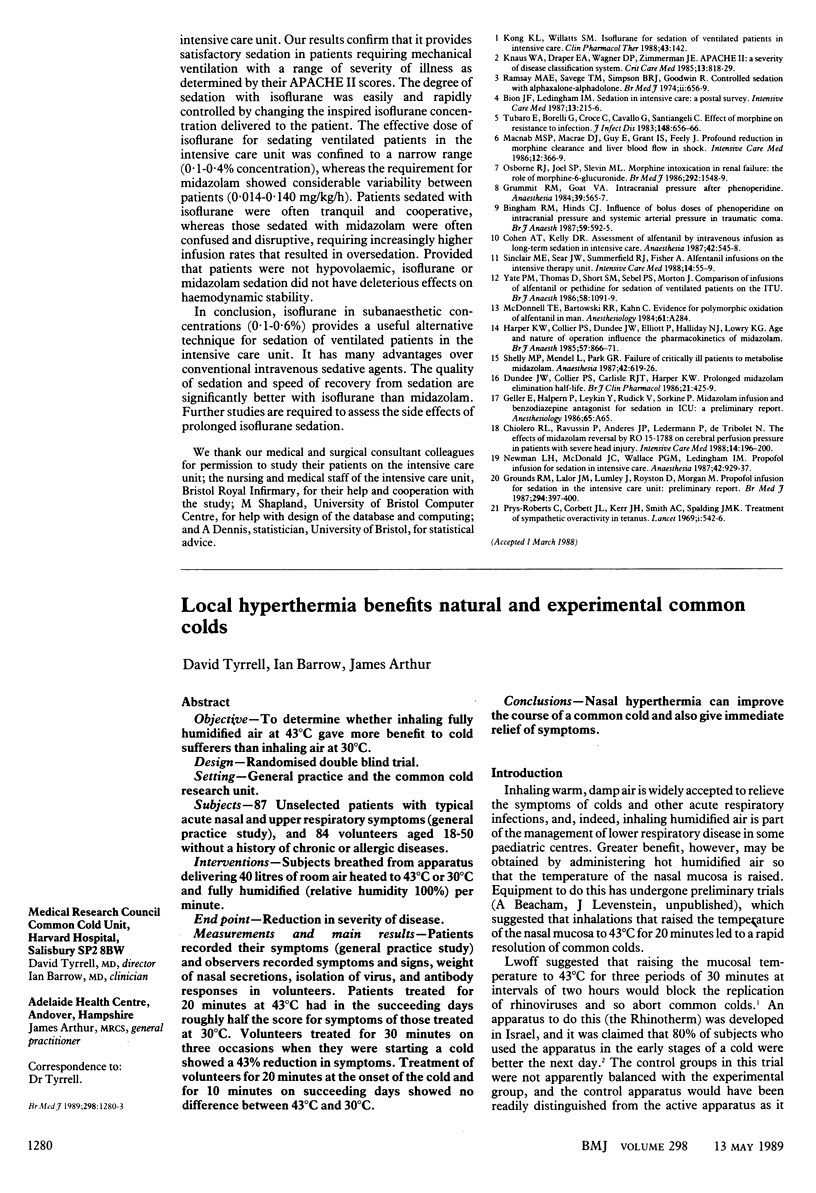Abstract
OBJECTIVE--To compare isoflurane with midazolam for sedation of ventilated patients. DESIGN--Randomised control study. Setting--Intensive care unit in university teaching hospital. PATIENTS--Sixty patients aged 18-76 who required mechanical ventilation. INTERVENTIONS--Sedation with either 0.1-0.6% isoflurane in an air-oxygen mixture (30 patients) or a continuous intravenous infusion of midazolam 0.01-0.20 mg/kg/h (30 patients). Sedation was assessed initially and hourly thereafter on a six point scale. Incremental intravenous doses of morphine 0.05 mg/kg were given for analgesia as required. The trial sedative was stopped when the patient was judged ready for weaning from ventilatory support or at 24 hours (whichever was earlier). END POINT--Achievement of a predetermined level of sedation for as much of the time as possible. MAIN RESULTS--Isoflurane produced satisfactory sedation for a greater proportion of time (86%) than midazolam (64%), and patients sedated with isoflurane recovered more rapidly from sedation. CONCLUSION--Isoflurane is a promising alternative technique for sedation of ventilated patients in the intensive care unit.
Full text
PDF



Selected References
These references are in PubMed. This may not be the complete list of references from this article.
- Bingham R. M., Hinds C. J. Influence of bolus doses of phenoperidine on intracranial pressure and systemic arterial pressure in traumatic coma. Br J Anaesth. 1987 May;59(5):592–595. doi: 10.1093/bja/59.5.592. [DOI] [PubMed] [Google Scholar]
- Bion J. F., Ledingham I. M. Sedation in intensive care--a postal survey. Intensive Care Med. 1987;13(3):215–216. [PubMed] [Google Scholar]
- Chiolero R. L., Ravussin P., Anderes J. P., Ledermann P., de Tribolet N. The effects of midazolam reversal by RO 15-1788 on cerebral perfusion pressure in patients with severe head injury. Intensive Care Med. 1988;14(3):196–200. doi: 10.1007/BF00717986. [DOI] [PubMed] [Google Scholar]
- Cohen A. T., Kelly D. R. Assessment of alfentanil by intravenous infusion as long-term sedation in intensive care. Anaesthesia. 1987 May;42(5):545–548. doi: 10.1111/j.1365-2044.1987.tb04052.x. [DOI] [PubMed] [Google Scholar]
- Dundee J. W., Collier P. S., Carlisle R. J., Harper K. W. Prolonged midazolam elimination half-life. Br J Clin Pharmacol. 1986 Apr;21(4):425–429. doi: 10.1111/j.1365-2125.1986.tb05217.x. [DOI] [PMC free article] [PubMed] [Google Scholar]
- Grounds R. M., Lalor J. M., Lumley J., Royston D., Morgan M. Propofol infusion for sedation in the intensive care unit: preliminary report. Br Med J (Clin Res Ed) 1987 Feb 14;294(6569):397–400. doi: 10.1136/bmj.294.6569.397. [DOI] [PMC free article] [PubMed] [Google Scholar]
- Grummitt R. M., Goat V. A. Intracranial pressure after phenoperidine. Anaesthesia. 1984 Jun;39(6):565–567. doi: 10.1111/j.1365-2044.1984.tb07363.x. [DOI] [PubMed] [Google Scholar]
- Harper K. W., Collier P. S., Dundee J. W., Elliott P., Halliday N. J., Lowry K. G. Age and nature of operation influence the pharmacokinetics of midazolam. Br J Anaesth. 1985 Sep;57(9):866–871. doi: 10.1093/bja/57.9.866. [DOI] [PubMed] [Google Scholar]
- Knaus W. A., Draper E. A., Wagner D. P., Zimmerman J. E. APACHE II: a severity of disease classification system. Crit Care Med. 1985 Oct;13(10):818–829. [PubMed] [Google Scholar]
- Macnab M. S., Macrae D. J., Guy E., Grant I. S., Feely J. Profound reduction in morphine clearance and liver blood flow in shock. Intensive Care Med. 1986;12(5):366–369. doi: 10.1007/BF00292927. [DOI] [PubMed] [Google Scholar]
- Newman L. H., McDonald J. C., Wallace P. G., Ledingham I. M. Propofol infusion for sedation in intensive care. Anaesthesia. 1987 Sep;42(9):929–937. doi: 10.1111/j.1365-2044.1987.tb05362.x. [DOI] [PubMed] [Google Scholar]
- Osborne R. J., Joel S. P., Slevin M. L. Morphine intoxication in renal failure: the role of morphine-6-glucuronide. Br Med J (Clin Res Ed) 1986 Jun 14;292(6535):1548–1549. doi: 10.1136/bmj.292.6535.1548. [DOI] [PMC free article] [PubMed] [Google Scholar]
- Prys-Roberts C., Corbett J. L., Kerr J. H., Smith A. C., Spalding J. M. Treatment of sympathetic overactivity in tetanus. Lancet. 1969 Mar 15;1(7594):542–545. doi: 10.1016/s0140-6736(69)91956-4. [DOI] [PubMed] [Google Scholar]
- Ramsay M. A., Savege T. M., Simpson B. R., Goodwin R. Controlled sedation with alphaxalone-alphadolone. Br Med J. 1974 Jun 22;2(5920):656–659. doi: 10.1136/bmj.2.5920.656. [DOI] [PMC free article] [PubMed] [Google Scholar]
- Shelly M. P., Mendel L., Park G. R. Failure of critically ill patients to metabolise midazolam. Anaesthesia. 1987 Jun;42(6):619–626. doi: 10.1111/j.1365-2044.1987.tb03086.x. [DOI] [PubMed] [Google Scholar]
- Sinclair M. E., Sear J. W., Summerfield R. J., Fisher A. Alfentanil infusions on the intensive therapy unit. Intensive Care Med. 1988;14(1):55–59. doi: 10.1007/BF00254123. [DOI] [PubMed] [Google Scholar]
- Tubaro E., Borelli G., Croce C., Cavallo G., Santiangeli C. Effect of morphine on resistance to infection. J Infect Dis. 1983 Oct;148(4):656–666. doi: 10.1093/infdis/148.4.656. [DOI] [PubMed] [Google Scholar]
- Yate P. M., Thomas D., Short S. M., Sebel P. S., Morton J. Comparison of infusions of alfentanil or pethidine for sedation of ventilated patients on the ITU. Br J Anaesth. 1986 Oct;58(10):1091–1099. doi: 10.1093/bja/58.10.1091. [DOI] [PubMed] [Google Scholar]


